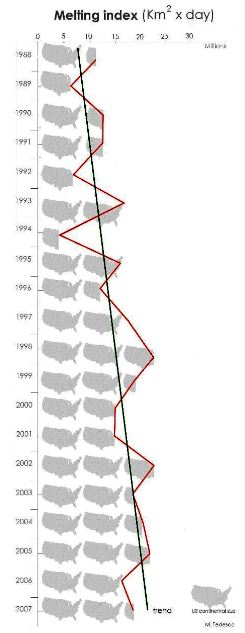A 2007 article from NASA contains this remarkable statement :
“the amount of snow that has melted this year over Greenland is the equivalent of more than twice the surface size of the U.S.”
Given that Greenland is much smaller than the US, one might wonder how the area of snow melt could exceed the surface area of the US?
Here is the ill-logic behind the claim. The author invented a new unit – km² x days, which is not a unit of area. He generated the number by multiplying the area of melt times the length of the melt season.
Fair enough. But doing a comparison vs. an area measurement is meaningless. The ratio of km²-days / km² has units of days – it is not a ratio of areas.
To highlight how meaningless this I will give another example. The area of Colorado is 250,000 km². We probably had close to 1 million seconds of snow melt last year. That means that there were 250 billion km²-seconds of melt last winter. Using the author’s logic, 4x more snow melted in Colorado than the surface area of Jupiter – 62 billion km²-
The unit km²-days may be a useful metric for comparison against other years. It is not a meaningful metric for comparison against an area.




Which just goes to show that, with a belief system, anything is possible. Create your very own metric and prove anything. Oh well, just look where this thing came from — NASA, home ground of GISS, located in (where else?) Manhattan, another well-worn metric of note. Those Manhattan critters don’t get out much, do they?
logic? logic now matters in global warming? 😉
My yawns over global warming predictions are now twice the size of the United States.
Ahh, didn’t you know that the snow in Greenland was very rough and in the form of skyscrapers and massive valleys, thus presenting more surface areas than a physical map would show? Some models have shown the snow in Greenland to possess a higher surface area density than activated carbon, and we all know that the surface of the U.S. is atomically smooth.
On a more serious note, my guess is that someone (a) got their projections wrong, or (b) intentionally got their projections wrong assuming most laymen look at projections where Greenland looks supermassive. Or wait, (c) did a unit conversion wrong.
-Scott